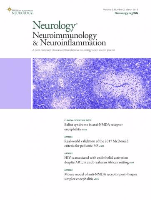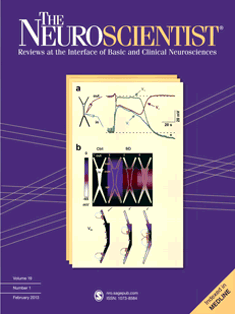
Neurology-Neuroimmunology & Neuroinflammation
Scope & Guideline
Connecting researchers and clinicians in neuroimmunology.
Introduction
Aims and Scopes
- Autoimmune Neurological Disorders:
The journal publishes research on various autoimmune neurological disorders, including multiple sclerosis, neuromyelitis optica spectrum disorders, and autoimmune encephalitis, highlighting diagnostic, therapeutic, and prognostic aspects. - Neuroinflammation:
Articles often explore the mechanisms of neuroinflammation and its role in neurological diseases, including the cellular and molecular pathways involved in immune responses within the CNS. - Biomarkers and Diagnostics:
The journal emphasizes the identification and validation of biomarkers for diagnosing and monitoring neurological diseases, particularly autoimmune conditions, which are critical for personalized medicine. - Therapeutic Interventions:
Research includes clinical trials and studies on novel treatment strategies, including immunotherapies and disease-modifying therapies, aimed at managing autoimmune neurological conditions. - Genetic and Environmental Factors:
The journal investigates the genetic predispositions and environmental triggers associated with autoimmune neurological disorders, contributing to the understanding of disease etiology.
Trending and Emerging
- Long COVID and Neurological Implications:
The impact of COVID-19 on neurological health, particularly in the context of post-viral syndromes, has garnered increased attention, indicating a growing recognition of the long-term effects of viral infections on the nervous system. - Precision Medicine in Neurology:
There is a rising trend towards personalized treatment approaches in autoimmune neurological disorders, focusing on individual genetic, biomarker, and environmental profiles to tailor therapies. - Single-Cell and Multi-Omics Approaches:
The use of advanced techniques such as single-cell RNA sequencing and multi-omics analyses is becoming more prominent, enabling researchers to dissect the complexity of immune responses in neurological diseases. - Neuroinflammation as a Therapeutic Target:
Emerging studies are increasingly targeting neuroinflammation as a modifiable component of disease pathology, exploring novel anti-inflammatory therapies that could improve clinical outcomes. - Integration of Machine Learning and AI in Diagnostics:
The application of machine learning and artificial intelligence in the diagnosis and management of neuroimmunological diseases is becoming a focal point, reflecting a trend towards innovative technological solutions in clinical practice.
Declining or Waning
- Traditional Neuroimmunology Concepts:
Research that adheres strictly to classical definitions and mechanisms of neuroimmunology without integrating newer findings or technologies has become less frequent, as the field evolves towards more nuanced understandings. - General Neurology Studies:
There is a noted decline in studies that focus broadly on neurology without a specific immune or inflammatory component, as the journal prioritizes research that directly ties neurology to immunology. - Basic Science Research:
While foundational studies are crucial, there appears to be a waning interest in purely basic science research without clinical implications, as the journal increasingly favors translational studies that bridge laboratory findings with clinical applications.
Similar Journals

Frontiers in Neurology
Advancing the Frontiers of Neurological ScienceFrontiers in Neurology is a premier open-access journal dedicated to the advancement of research in the field of neurology, published by FRONTIERS MEDIA SA since 2010. With the ISSN 1664-2295 and an international reach established from its base in Lausanne, Switzerland, this journal has rapidly become a vital resource for neurologists and neuroscientists alike, presenting high-quality research that addresses critical developments in clinical and experimental neurology. Holding a solid Q2 quartile ranking in both neurology and clinical neurology, Frontiers in Neurology demonstrates substantial influence, evidenced by its respectable Scopus rankings—151st in clinical neurology and 77th in neuroscience neurology. The journal employs robust peer review practices to ensure rigor and integrity, while its open-access model fosters widespread dissemination of knowledge. By facilitating interdisciplinary dialogue and empowering research efforts, this journal not only supports the academic community but also contributes to the advancement of treatment and understanding of neurological disorders.

NEUROSCIENTIST
Driving Excellence in Neuroscience ScholarshipNEUROSCIENTIST is a leading journal in the field of clinical neurology and neuroscience, published by SAGE Publications Inc. With an impressive impact factor reflected in its Q1 quartile ranking in both clinical neurology and miscellaneous neuroscience as of 2023, this journal positions itself as a crucial platform for the latest research and advancements in the neural sciences. Spanning from 1995 to 2024, NEUROSCIENTIST features a range of high-quality, peer-reviewed articles that cater to researchers, practitioners, and students alike. Although it does not offer Open Access options, the journal remains a vital resource owing to its Scopus rankings, situating it within the top percentile of its categories: ranked #28 out of 400 in clinical neurology and #15 out of 113 in general neuroscience. The journal's commitment to disseminating significant findings underlines its importance in fostering advancements in neurological understanding and treatment.

Journal of Neuroinflammation
Advancing the understanding of neuroinflammation and its impact on the brain.Journal of Neuroinflammation is a premier open-access journal published by BMC that has been at the forefront of research in the field since its inception in 2004. With a strong focus on the intricate interplay between the nervous system and immune responses, this journal aims to create a forum for the dissemination of high-quality research that informs our understanding of neuroinflammation and its implications in neurological disorders. Positioned in the top quartile across multiple categories including Cellular and Molecular Neuroscience, Immunology, and Neurology, the journal ranks impressively within the Scopus database, ensuring visibility to the global research community. The Journal of Neuroinflammation provides a vital platform for researchers and professionals to share groundbreaking findings, methodologies, and reviews that advance science and foster collaboration. With its commitment to open access, the journal ensures that its content is accessible to a broad audience, enhancing the dissemination of knowledge in this critical field of study.

Journal of Central Nervous System Disease
Exploring the frontiers of neuroscience.Welcome to the Journal of Central Nervous System Disease, a premier Open Access publication dedicated to advancing the understanding of neurological disorders and their underlying mechanisms. Published by SAGE Publications Ltd, this esteemed journal has been serving the scientific community since 2009 and is committed to disseminating high-quality research that spans from clinical neurology to cellular and molecular neuroscience. With an impressive impact factor, the journal ranks within the top quartiles—Q2 in both Neurology and Clinical Neurology, and Q3 in Cellular and Molecular Neuroscience as of 2023. The journal's indexing in Scopus reflects its significant contribution to the field, being ranked #83 out of 400 in clinical neurology and #38 out of 97 in cellular and molecular neuroscience. This essential resource, based in the United States, is crucial for researchers, clinicians, and students looking to stay at the forefront of neurological science. By providing Open Access options, we ensure that groundbreaking research is readily available to a global audience, fostering collaboration and innovation in the study of central nervous system diseases.

Alzheimers Research & Therapy
Fostering collaboration to combat neurodegenerative disorders.Alzheimer's Research & Therapy is a leading peer-reviewed journal published by BMC, dedicated to advancing our understanding of Alzheimer's disease and other neurodegenerative disorders. As an Open Access journal since 2009, it ensures that vital research findings are freely accessible to the global community, facilitating collaboration and innovation in the field. The journal's commitment to quality is evident in its impressive impact factor and its prestigious ranking in the Q1 quartile across multiple categories including Cognitive Neuroscience and Neurology. With a Scopus rank placing it in the top tier of both Neuroscience and Neurology disciplines, Alzheimer's Research & Therapy serves as a crucial platform for researchers, clinicians, and students who seek to contribute to the fight against Alzheimer's and related disorders. The journal covers a wide range of topics and actively encourages submissions that explore therapeutic strategies and innovative research methodologies, enriching the scientific dialogue in this vital area of health.

NEUROMOLECULAR MEDICINE
Pioneering Research in Cellular Neuroscience and MedicineNEUROMOLECULAR MEDICINE, published by HUMANA PRESS INC, is a prestigious peer-reviewed journal dedicated to advancing the fields of cellular and molecular neuroscience, molecular medicine, and neurology. With an ISSN of 1535-1084 and an E-ISSN of 1559-1174, the journal boasts a significant presence in academic research since its inception in 2002 and continues to publish cutting-edge studies through 2024. Ranked in the Q2 category for 2023 in various disciplines, including Neuroscience and Molecular Medicine, it holds impressive positions in Scopus rankings, including 41st out of 192 in Neuroscience and Neurology. Although not an open access journal, NEUROMOLECULAR MEDICINE remains invaluable for researchers, professionals, and students seeking to explore the intricate relationships between molecular mechanisms and neurological functions, thereby contributing to the scientific understanding of nervous system diseases and therapeutic innovations.

EXPERIMENTAL NEUROLOGY
Exploring Innovative Pathways in Developmental Neuroscience.EXPERIMENTAL NEUROLOGY is a premier academic journal published by Academic Press Inc, Elsevier Science, focusing on advancements in the fields of Developmental Neuroscience and Neurology. With an impressive Impact Factor and ranked in the Q1 quartile of both categories—positioning it among the top-tier journals—this publication has established itself as a vital resource for researchers, clinicians, and students alike. Since its inception in 1959, it has fostered the dissemination of cutting-edge research and innovative approaches to understanding neurological function and related disorders. While EXPERIMENTAL NEUROLOGY currently operates under a subscription access model, its rich archives and ongoing contributions to the field continue to inspire and inform the next generation of neurobiologists. The journal also boasts a high ranking in Scopus, placing fourth in Developmental Neuroscience and twentieth in Neurology, indicating its robust influence and scholarly significance. For those committed to advancing knowledge in these critical areas, EXPERIMENTAL NEUROLOGY is an indispensable platform for inquiry and discovery.

NEUROLOGICAL SCIENCES
Innovative research shaping the future of neurological sciences.NEUROLOGICAL SCIENCES, published by SPRINGER-VERLAG ITALIA SRL, is a premier journal that has been a cornerstone in the field of neurology and related disciplines since its inception in 1996. With an impressive Q1 ranking in Dermatology and Q2 rankings in Neuroloy (clinical) as well as Psychiatry and Mental Health, this journal consistently delivers high-quality peer-reviewed research that informs and shapes clinical practice. The journal boasts a significant presence on Scopus, positioned in the 89th percentile for Dermatology, 73rd for Psychiatry and Mental Health, and 72nd for Neurology (clinical), reflecting its influential contributions to medical knowledge. Open Access options are available, ensuring that this valuable research is accessible to a wider audience committed to advancing their understanding of neurological sciences. As it converges into future years (2024 and beyond), NEUROLOGICAL SCIENCES aims to continue foster collaboration and innovation amongst researchers, professionals, and students within the neurology and mental health domains, making it an indispensable resource for those dedicated to improving patient outcomes and advancing scholarly dialogue.

Neurotherapeutics
Bridging Knowledge and Innovation in Neurotherapeutics.Neurotherapeutics, published by Springer, is a leading Open Access journal dedicated to the field of neurology and pharmacology, specifically focusing on innovative therapeutic approaches for neurological disorders. With an impressive impact factor and recognized as a prestigious outlet in its domain—ranking Q1 in Neurology (Clinical) and Pharmacology—this journal serves as an invaluable resource for researchers, healthcare professionals, and students aiming to stay updated with the latest advancements in neurotherapeutics. Since its inception in 2007 and now transitioning to Open Access from 2024, Neurotherapeutics enhances accessibility to high-quality research, ensuring that critical findings reach a global audience. Its current Scopus rankings further underscore its significance, placing it within the top echelons of pharmacology and clinical neurology. By fostering a robust platform for the dissemination of pioneering research, Neurotherapeutics plays a crucial role in shaping the future of neurological treatment and care.

INTERNATIONAL JOURNAL OF NEUROSCIENCE
Advancing the Frontiers of Neuroscience KnowledgeThe INTERNATIONAL JOURNAL OF NEUROSCIENCE, published by TAYLOR & FRANCIS LTD, stands as a vital resource in the field of neuroscience since its inception. With a proud history of publication from 1970 to 2024, this journal is committed to advancing knowledge in various domains of neuroscience, from fundamental research to clinical applications. It is indexed with an ISSN of 0020-7454 and an E-ISSN of 1563-5279, reflecting its wide reach and recognition. The journal maintains a respectable position in the academic landscape, categorized as Q2 in Medicine (miscellaneous) and Q3 in Neuroscience (miscellaneous) as of 2023, signifying its relevance among researchers and professionals. Although it currently does not offer open access, the journal remains a significant platform for disseminating groundbreaking research, thereby fostering collaboration and innovation within the neuroscience community. Located in the United Kingdom, the journal aims to bridge gaps in neuroscience knowledge, making it an essential reading for students, professionals, and researchers dedicated to unraveling the complexities of the nervous system.